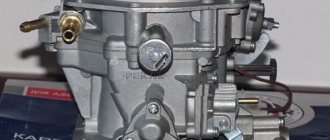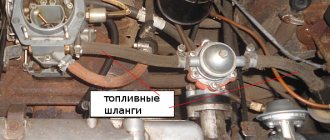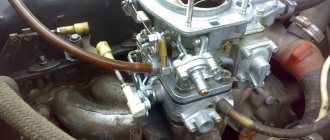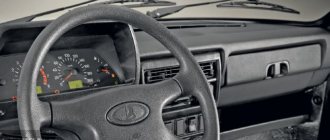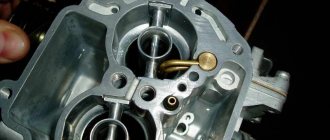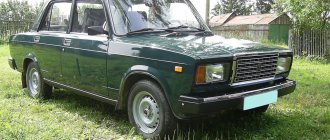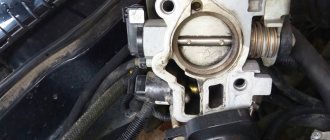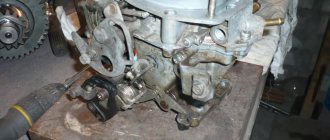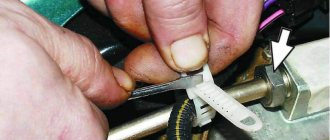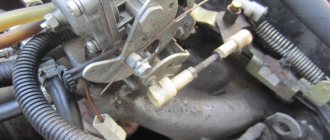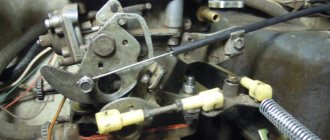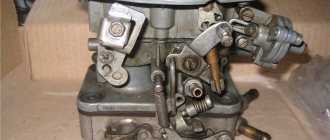One of the problems that a car enthusiast who owns a domestic VAZ 2109 may encounter is that the carburetor stalls while driving. A large number of articles are devoted to this topic, but real experience will allow you to solve the problem faster, since there are several reasons for this.
So, professionals who had experience solving the problem of a VAZ 2109 with a carburetor engine stalling at idle found several reasons and ways to solve them.
Causes and solutions
When the VAZ 2109 carburetor stalls at idle, that is, when your foot is on the gas pedal, the car works flawlessly, and as soon as you lower it, it stalls, you should look for the cause in the idle speed solenoid valve. To find the reason, you need to understand the meaning of the machine. Thus, the carburetor of the car has an idle system, which consists of a fuel channel with a nozzle, an air channel and a solenoid valve. When the car is idling, fuel moves through a special idle passage into the engine. To ensure that the car operates at idle speed, there are holes on the nozzle.
What kind of malfunction causes the idle speed to disappear?
There may be two reasons:
- Problems with fuel supply at idle.
- There is an air leak in the system, which disrupts the optimal proportion of air and gasoline in the combustible mixture.
In the first case, the responsibility falls on the idle air solenoid valve. If it malfunctions, fuel will not be able to flow into the engine.
To eliminate the cause, you should remove the air filter, from which the cover is then removed. After this, a mini service check is carried out. With the ignition on, remove and place the chip on the valve. The serviceability of the coil is indicated by characteristic clicks that are heard during manipulations. But to be completely sure of serviceability, you should unscrew the valve. To do this, use key No. 13. Then remove the jet and check for contamination. Blowing air through your mouth, see if it passes through it normally. After such a check, you need to close the hole in the EAC (hereinafter the idle speed solenoid valve) with your finger and turn on the ignition. This procedure will blow out any debris that has accumulated in front of the fuel jet, if there is any there.
You should also check the integrity of the rubber seal. If there is damage, deformation or a loose fit, air will be sucked in, which is why the machine will malfunction when idling.
If there is no characteristic click when removing and putting on the chip, then you should check whether there is voltage. If it is missing, you should check the carburetor throttle economizer.
If there is voltage, but there is nothing to replace the valve with (the breakdown occurred on the road), then you can take emergency measures that will allow you to complete the route. To do this, you need to remove the nozzle and break off the plastic needle and put the nozzle in place. In this case, there is no need to put a wire on the EPHH.
Carburetor repair by specialists is the best solution
If you have a carbureted car, it would be best to find a professional who can service the equipment regularly. Your car will require high-quality maintenance on a regular basis, since the carburetor is constantly becoming clogged and presents more and more problems in operation. Therefore, it would be best to use the services of a specialist who knows his business very well and performs cleaning, regular maintenance and repair of carburetors, as well as all related equipment. The main criteria for choosing a specialist are as follows:
- experience in working with your car model, sufficient professionalism, confirmed by years of work;
- positive reviews from other owners of carburetor cars who received quality service;
- affordable prices - you don’t have to choose an expensive service station, you can cooperate with a private master;
- fairly quick completion of all necessary repair work, but the presence of a guarantee of the quality of the result;
- the possibility of ordering complex work with the purchase of spare parts performed by a specialist in order to relieve oneself of responsibility for the quality of parts;
- other convenient services, as well as the possibility of full vehicle maintenance.
It is convenient when all repairs and maintenance are carried out by one person. This makes it quite easy to get a high-quality working car, since one person or one company is responsible for it. If one person repairs your carburetor, another person maintains the car, and a third person solves problems with the generator, all this is not very convenient for repair work on the car. So it’s better to find a universal specialist and constantly service the car exclusively from him. If you have a Solex carburetor installed on your car, we suggest watching a video about its disassembly and maintenance:
Causes of the problem
Quite often, VAZ 2109 owners are faced with a problem when the carburetor does not hold speed while idling, and the engine simply stalls. There can be many reasons, and they are all united by a number of characteristic features.
The first reason is a clogged idle jet. Even though the fuel supply system has 2 filters (coarse and fine), even one speck may be enough to clog the nozzle.
fine filter
Also, the fine filter itself may become clogged. This often happens when the filter was not replaced with a new one in time. Less commonly, malfunctions in the idle system occur.
There is no difference at all between the symptoms for any of the causes of the problem. Determining what exactly needs to be cleaned or changed can only be done through a visual inspection or diagnostics.
Also, sometimes the revs not only disappear completely, but also float. At the same time, the VAZ 2109 car does not stall. In this case, to the above reasons, you should add: a faulty solenoid valve or idle speed sensor.
In my case, the thread on the carburetor cap is knocked off and the idle air valve does not tighten tightly and is not working at all. No idle speed. The car runs on choke, as soon as you close the choke, the car immediately stalls. Is it possible to somehow turn off the idle air valve instead?
Special plugs are sold that are screwed into the hole for the valve in the carburetor. This plug also contains an idle jet - a regular hole of a certain diameter. You unscrew the valve and a plug is screwed in instead. One of the advantages of the plug is that there are no hemorrhoids as with the valve. Of the minuses, on a hot engine there will be detonation when you turn off the engine. Detonation occurs because the valve closes the idle fuel channel when the ignition is turned off; when the plug is plugged, there is no one to close this channel.
Thanks for the advice, I’ll try to find a plug and hope to solve the idle problem this way
My advice to you is not to drive with a broken valve piece or a plug. It greatly affects the performance of the engine. Detonation is very harmful to the engine and shortens its life.
How to fix such a breakdown on the road?
Of course, if the valve fails on the road, then breaking off the valve needle is the only solution. Upon arrival home, it is better to buy a new valve and screw it in.
Please tell me. The car starts up perfectly, it runs for about 10 seconds and the revs drop, the engine starts to stall, if you turn it up at speed, it starts moving, the same thing, the gas jerks to the floor, it goes as soon as you remove it, or it even stalls.
It is not clear why the machine works normally for the first 10 seconds. Do you press the gas pedal during these first 10 seconds? Does the VAZ 2109 have a carburetor?
VAZ 2109 carburetor, I don’t use gas for long. Today I changed the solenoid valve, it seems to be better, but suddenly the gas does not develop at half speed, as if something was missing. Maybe something with the carb.
Troubleshooting
In order to fix this problem, you need to determine the culprit. Once you have located the location where the problem occurred, you can begin preparing for the repair work. First of all, check whether the carburetor is set correctly. To do this, tighten the quality screw and the quantity screw until it stops, and then unscrew it as indicated in the factory settings of the carburetor (often, the carburetor settings are as follows: quality screw - 2.5 turns, quantity screw - 4 turns). If there are no changes, and the engine still does not idle, or even stalls, then you need to look for the reason, choosing from the above.
How to repair idle speed on a VAZ 2109 carburetor engine
On cars of the VAZ 2109 family, Solex-type carburetors are used, which have an electromagnetic valve (EMV) with an idle jet in the idle speed system. The valve is controlled by the electronic forced idle unit.
There are three most common causes of idle speed disappearance:
- clogging of the EMC idle jet;
- EMC burnout;
- lack of power supply to the EMC.
For work you need: wrenches “8”, “10”, “12”, “13”, “14”, a 12 V probe or test lamp with wires, a piece of wire with stripped ends, a compressor or air pump.
Remove the air filter housing cover by unscrewing the nut with a “10” wrench and unfastening the spring clips. Remove the air filter.
We unscrew the four nuts with a key “8”, use a screwdriver to loosen the clamp of the crankcase ventilation hose at the point of connection to the valve cover and remove the air filter housing.
Turn on the ignition. Remove the power wire from the solenoid valve.
We try to touch the power wire terminal to the EMC terminal several times. At the moment of contact, distinct clicks should be heard. If this is not the case, then unscrew the EMC from the carburetor cover. Using an additional piece of wire, we apply the “+” from the battery to the terminal of the EMC, and with its body we touch the “–” terminal of the battery several times. At the moment of contact, distinct clicks should be heard.
If there are no clicks, the valve is burnt out. We replace it with a serviceable one, after checking it first.
To get to the nearest auto shop, you can convert a faulty EMC into a forced open one. To do this, remove the idle fuel jet with two fingers, break off the plastic tip of the valve, and put the jet and EMC in place.
We put the wires in place and start the engine. When using such a valve, problems may arise with turning off the engine: it will try to work after the ignition is turned off. In such a situation, you don’t need to turn it off right away, but let it run for 1-2 minutes, and after turning off the ignition, smoothly press the gas pedal all the way.
If the EMC is working normally, you need to check the idle jet. To do this, unscrew the valve from the carburetor cover. Using two fingers, remove the idle fuel jet. Pay attention to the central hole: remove debris from it using a compressor or air pump.
We install the jet and EMC in place and tighten it until it stops.
If the solenoid valve is working properly, the jet is not clogged, and there is still no idle speed, then the electronic forced idle speed control unit may have failed.
How to check it? Turn on the ignition and check with a tester or test lamp for the presence of “+” at the terminal of the EMC power wire.
If there is no power, the electronic forced idle control unit has failed. It cannot be repaired. Replacing it is not difficult. To get to the nearest auto shop, you can temporarily use an additional wire to supply power to the EMC at least from the “+B” terminal of the ignition coil. As an option, you can first bend the rubber cover from the connector of the wire bundle of the forced idle block and connect the wires at terminals “4” and “6” with a jumper. The numbering order of the terminals is indicated on the cover of the electronic unit to the right and left of the connector - numbers “1” and “7”.
A frequent malfunction of the engine associated with the forced idle block is a significant decrease in rotation speed (up to a complete stop) when the clutch is depressed, for example, when changing gears or stopping at a traffic light. In this case, in order to safely get to a car shop or service center, it is enough to disconnect the connector of the control circuit of the forced idle unit, located near the mixture amount adjusting screw.
Diagnostic sequence
No specialist can give any precise recommendations on the diagnostic sequence, but if the problem of a suddenly stalling engine appears periodically, you can wait a little and try to determine under what circumstances it occurs. It would also be a good idea to visit specialized forums dedicated to the problems of a particular make and model of car.
To carry out the most accurate diagnostics, it is recommended to connect the car to a special diagnostic device, which can be found at any specialized service station.
VAZ 2109 carburetor does not idle
- Registration
- Entrance
- To the beginning of the forum
- Forum Rules
- Old design
- FAQ
- Search
- Users
- List of forums AUTOLADA.RU
- Family "Samara"
- 1
- 2
- 3
- >
Maybe of course this is just strange for me, but here is a description of the problem:
The carburetor nine stalls while driving. Moreover, the distance and time intervals can be completely different (you can drive 20 kilometers, or you can only drive 1). It stalls, the revs drop, and if you press the gas pedal to the floor at the same time, the car will somehow move terribly stupidly. If you pull out the choke all the way, then in principle the movement can continue at a normal pace. If you stop at this moment, the car stalls and when you try to start, it runs for two seconds and stalls again. You can start and drive only if you pull the choke to 3-3.5t idle. By turning off the car and waiting 10-15 minutes, you can start normally again and drive on.
So the question is: what is the problem?
It seems like I did everything I could. I visited the carburetor people (at that moment the car was working perfectly well, so I described my problem to them verbally). adjusted/cleaned the carburetor, checked the fuel pump, EMC, ignition. look like that's it. I changed the spark plugs, air filter and photo, even removed the gas tank in search of some dirt, but everything turned out to be clean.
I can’t imagine what else can be done -.-
Maybe of course this is just strange for me, but here is a description of the problem:
The carburetor nine stalls while driving. Moreover, the distance and time intervals can be completely different (you can drive 20 kilometers, or you can only drive 1). It stalls, the revs drop, and if you press the gas pedal to the floor at the same time, the car will somehow move terribly stupidly. If you pull out the choke all the way, then in principle the movement can continue at a normal pace. If you stop at this moment, the car stalls and when you try to start, it runs for two seconds and stalls again. You can start and drive only if you pull the choke to 3-3.5t idle. By turning off the car and waiting 10-15 minutes, you can start normally again and drive on.
So the question is: what is the problem?
It seems like I did everything I could. I visited the carburetor people (at that moment the car was working perfectly well, so I described my problem to them verbally). adjusted/cleaned the carburetor, checked the fuel pump, EMC, ignition. look like that's it. I changed the spark plugs, air filter and photo, even removed the gas tank in search of some dirt, but everything turned out to be clean.
I can’t imagine what else can be done -.-
After waiting 10-15 minutes you can start normally again and drive on.
dryffery
I'll try another switch
Check all fuel hoses for air leaks, and also change all the old clamps at the same time. It is also useful to blow out the carburetor again - pull out the jets and blow them out with a compressor, don’t even try using a pump. Well, I’m already silent about the fact that there should be a filter in front of the fuel pump. By the way, if you replace the fuel pump with a Peker one, you will forget about its existence for a long time.
it's all done. And by the way, the petrol pump is Peker's.
ALEX_69
I'll try to clean it this way, but it's doubtful. The carburetor was completely disassembled and cleaned/blown
Seryoga
The contacts on the switch are fine, and so are the contacts on the distributor. I'll try another hall sensor.
alex_B
Everything is fine with the fuel pump, and this is not due to overheating.
Vivisector
I inspected the fuel line and found no visible damage. all equally dusty and dry.
Aleksey_Sh
The contacts are good everywhere, but maybe I’ll try another emc and a second emc.
Olegovich
I haven’t checked the coil, but as an option I’ll see what’s wrong with it in the dark.
The symptoms of the disease have changed a little. Now the car starts with the choke fully extended and the idle speed varies from 1000 to 2500 back and forth, back and forth as long as desired.
and another question. I saw a theory somewhere that maybe the fuel pump rod was worn out. Is this possible in this case?
and another question. I saw a theory somewhere that maybe the fuel pump rod was worn out. Is this possible in this case?
it's all done. And by the way, the petrol pump is Peker's.
It was a one-on-one situation. The revs fluctuated and the engine stalled. Well, they destroyed the carburetor, blew it out where they could, and the car drove off. I wandered around the city for about four kilometers, went out to the Moscow Ring Road, took a drink slowly, listened to Bob Marley. The engine stalls. Well, it was evening, there were few cars, I was from the fourth row on the emergency gang to the side of the road. I smoked, kicked the wheels, to no avail. But we need to go. I pulled out the choke, accelerated to third, and drove the remaining 50 kilometers like on a cruise, although I had to pump up the gas pedal like on a bike - the engine sometimes tried to stall.
The next day they fitted me with a new carb, just from the store. Put. The picture is the same - the revs fluctuate, the car jerks. Somehow I got to the carburetor people, washed it with cleaner, blew it out, and replaced the needle. I drove a couple of kilometers away from them and was gone! again the same bullshit. I changed the fine filter, switch harness (one of the contacts was a little jammed there), spark plugs, high voltage wires, switch, distributor slider. No way! The next day I again went to the carburetor specialists, they just shrugged their shoulders - everything was zero, but there was no point. In short, the new carb was cleaned three times. Only the third time they caught some kind of rubbish out of it, like a couple of small, almost dust-like pieces of dry leaves
Now the TAZ crashes as before, hehe!
Determining the quality of the spark
At this stage, you need to understand whether there is voltage on the spark plugs. To do this, just unscrew one spark plug and connect the central electrode to the high-voltage wire. Next, ensure that the threads are in contact with the ground of the car and turn on the ignition. A stable spark of blue (white-blue) color indicates that everything is fine with the ignition.
Check the remaining spark plugs in the same way. Because a common reason for an engine to fail to start is the failure of one of these parts.
After working for a while in this mode, the engine will stall.
Cylinders with non-functioning spark plugs are simply filled with too much gasoline and the situation will repeat itself when the engine is restarted. If there is a spark on all spark plugs, evaluate their color and size. Yellow/red color and small size also indicate that the car will start and subsequently stop working.
At this stage it is enough to replace the failed spark plugs
When purchasing parts, pay attention to the manufacturer’s recommendations regarding clearance and heat rating parameters
Lost idle speed (XX) of an engine with a Solex carburetor
The car engine may idle completely.
Malfunction - the engine only runs on choke. Or be unstable (the speed “floats” up and down, the engine shakes – “troits”, stalls after a short period of operation, stalls after pressing the gas pedal, etc.). Let's look at the reasons for the disappearance of idle speed on car engines with Solex carburetors 2108, 21081, 21083, 21073. Along the way, we'll look at methods for eliminating this malfunction.
